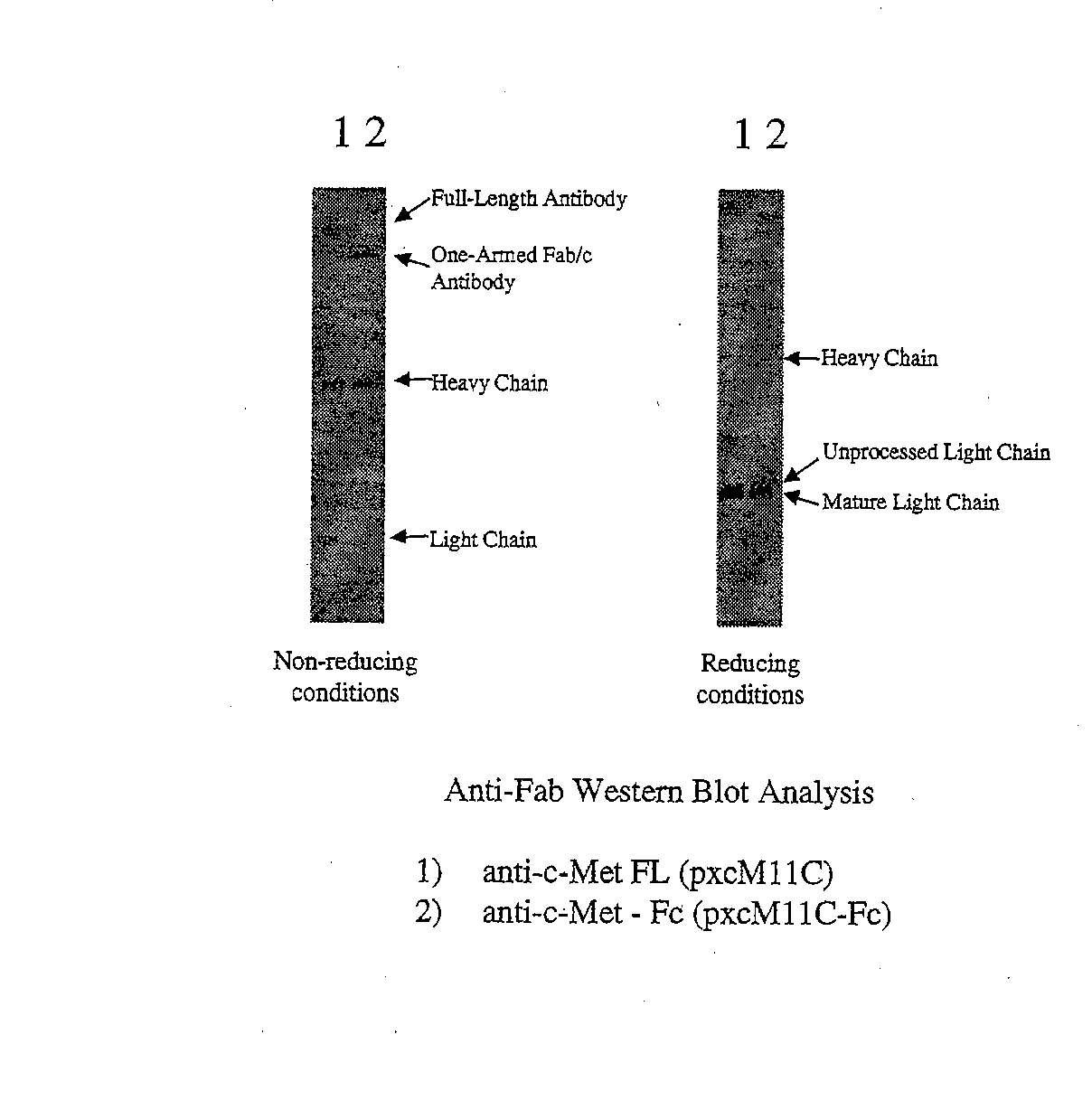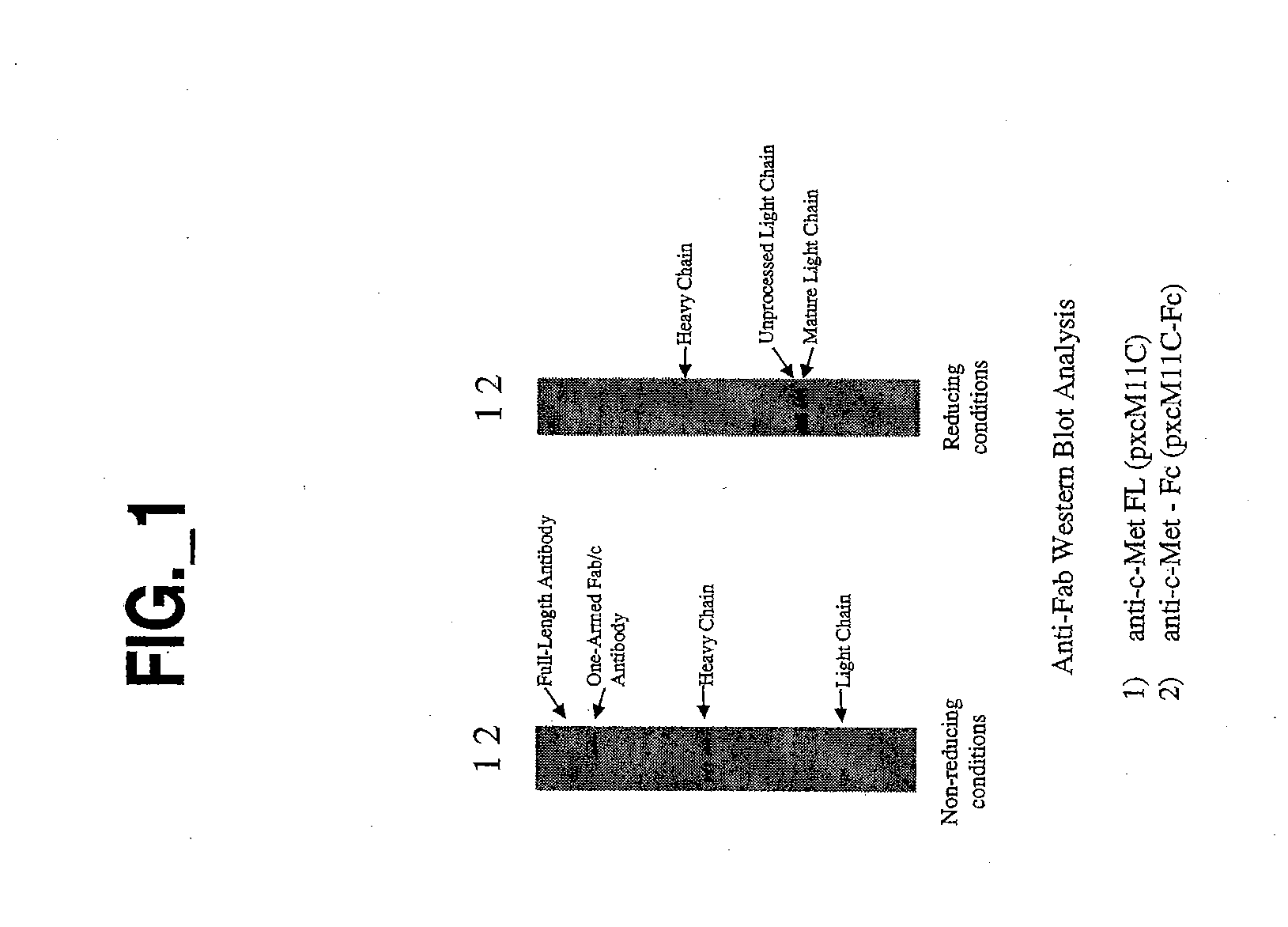Monovalent antibody fragments useful as therapeutics
a monovalent antibody and fragment technology, applied in the field of molecular biology and antibody therapeutics, can solve the problems of unnecessary or even deleterious functions of immune effectors, and achieve the effects of reducing clearance rate, superior pharmacokinetic attributes, and enhancing half li
- Summary
- Abstract
- Description
- Claims
- Application Information
AI Technical Summary
Benefits of technology
Problems solved by technology
Method used
Image
Examples
example 1
Generation and Characterization of an Antibody Fragment of the Invention
Also Referred to Below as “One-Armed Antibody” or “Fab / c Antibody”
Construction of Expression Vectors
[0278] All plasmids for the expression of full-length or Fab / c anti-c-met antibodies were based on a separate cistron system (Simmons et al., J. Immunol. Methods, 263: 133-147 (2002)) which relied on separate phoA promoters (AP) (Kikuchi et al., Nucleic Acids Res., 9: 5671-5678 (1981)) for the transcription of heavy and light chains and the Fc fragment, followed by the trp Shine-Dalgarno sequence for translation initiation (Yanofsky et al., Nucleic Acids Res., 9: 6647-6668 (1981) and Chang et al., Gene, 55: 189-196 (1987)). Additionally, the heat-stable enterotoxin II signal sequence (STII) (Picken et al., Infect. Immun., 42: 269-275 (1983) and Lee et al., Infect. Immun., 42: 264-268 (1983)) was used for periplasmic secretion of heavy and light chains and the Fc fragment. Fine control of translation for both ch...
example 2
Pharmacokinetic Characteristics and Therapeutic Efficacy of Antibodies of the Invention
Material & Methods
[0315] Materials—HGF and c-Met-IgG were produced at Genentech, as described previously (8; 14). Maxisorb microtiter plates were purchased from NUNC (Rosklide, Denmark). Anti-hFc was purchased from Jackson Immunochemical (West Grove, Pa.). HRP-Streptavidin was purchased from Zymed (South San Francisco, Calif.). 3H-thymidine was purchased from Amersham, Inc. (Arlington Heights, Ill.). MDA-MB-435 cells were obtained from ATCC (Rockville, Md.). Pyroglutamate aminopeptidase was obtained from Takara Biochemicals (Berkeley, Calif.). NHS-X-Biotin was purchased from Research Organics (Cleveland, Ohio). Immobilon-PSQ PVDF was purchased from Millipore (Marlborough, Mass.). Superscript II RNase H-Reverse Transcriptase was from Gibco-BRL (Gaithersburg, Md.). Taq polymerase was from Perkin Elmer-Cetus (Foster City, Calif.), Bakerbond ABX, 40μ particle size was from J. T. Baker (Phillipsburg...
PUM
| Property | Measurement | Unit |
|---|---|---|
| temperature | aaaaa | aaaaa |
| temperature | aaaaa | aaaaa |
| temperature | aaaaa | aaaaa |
Abstract
Description
Claims
Application Information
 Login to View More
Login to View More - R&D
- Intellectual Property
- Life Sciences
- Materials
- Tech Scout
- Unparalleled Data Quality
- Higher Quality Content
- 60% Fewer Hallucinations
Browse by: Latest US Patents, China's latest patents, Technical Efficacy Thesaurus, Application Domain, Technology Topic, Popular Technical Reports.
© 2025 PatSnap. All rights reserved.Legal|Privacy policy|Modern Slavery Act Transparency Statement|Sitemap|About US| Contact US: help@patsnap.com



